I was able to reassemble the room, system, measured again (an initial rough start) with the one dipole, and I'm really liking what I hear. I figured there is a way to get 24dB gain of of the Hilo for the channel used for the 18s so that helps a lot with overall system gain.
Bass is really good. Lots of definition! Listening to Pink Floyd's Wish You Were Here album (14dB dynamic range), Dark Side of the Moon (12dB DR) is something else.
Plenty of work still ahead, but this is looking good.
Cheers
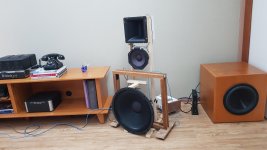
Bass is really good. Lots of definition! Listening to Pink Floyd's Wish You Were Here album (14dB dynamic range), Dark Side of the Moon (12dB DR) is something else.
Plenty of work still ahead, but this is looking good.
Cheers

Nice build. Minimum impedance on the B&C is 7.2ohms. Parallel a couple you'll have around 104db sensitivity, and they would easily do a 250hz crossover while still being close to the sensitivity of the ribbon after compensation.
A dipole with a sensitivity north of 98db. Yes please, I'll take two.
A dipole with a sensitivity north of 98db. Yes please, I'll take two.
Nice build. Minimum impedance on the B&C is 7.2ohms. Parallel a couple you'll have around 104db sensitivity, and they would easily do a 250hz crossover while still being close to the sensitivity of the ribbon after compensation.
A dipole with a sensitivity north of 98db. Yes please, I'll take two.
Thank you!
Interestingly, when I first set out to design I was shooting for 2A3 SET driving the tweeter, and another driving the midrange, so high sensitivity and high/flat impedance were important factors. I was thinking boxed MTM with these AMT tweeters and 8" mids, knowing lobbing would likely be an issue.
Eventually I tried dipole and I decided to go down this path, and I was giving away the thought of using 2A3 for highs and mids since these will likely need more power in their lower end. Doing dipole TMM as you suggest is a great idea and might help me get away with a SET. Will also try a small baffle for the mids and see how that changes things.
And play tones at the mid low xo point and measure voltage at amp terminals and SPL to get a better idea of the sensitivity.
Fun!
Thanks for the input.
The 2 mids could actually handle a lower crossover point based on volume displacement, but impedance will be limiting factor here, and you want to stay a couple octaves above Fs, as that's where resistance begins to rise.
So, 250-260 is a good compromise and will let you retain plenty of sensitivity after compensating for roll off. And with that crossover point they'll play louder than you'd ever want to listen and still be within x-max.
Have fun!
So, 250-260 is a good compromise and will let you retain plenty of sensitivity after compensating for roll off. And with that crossover point they'll play louder than you'd ever want to listen and still be within x-max.
Have fun!
wavelength chart
A bit of physics, offered here, to help those in need.
https://www.jdbsound.com/art/frequency wave length chart 2013.pdf
A bit of physics, offered here, to help those in need.
https://www.jdbsound.com/art/frequency wave length chart 2013.pdf
Nice build. Minimum impedance on the B&C is 7.2ohms. Parallel a couple you'll have around 104db sensitivity, and they would easily do a 250hz crossover while still being close to the sensitivity of the ribbon after compensation.
A dipole with a sensitivity north of 98db. Yes please, I'll take two.
I simulated on Edge:
- 1 naked 8PE21 (shown in green, Curve 1)
- 1 8PE21 on an oval baffle 250 x 450mm, where the woofer is placed at the top (shown purple, Curve 2)
- 2 8PE21 on same baffle as above. Top woofer placed on same spot, and second woofer below.
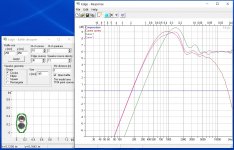
I ran the last two thinking of the 0.5 channel, meaning having an inductor between both at a frequency where the top woofer was 3dB down from peak.
So purple Curve 2 shows how this would work at higher frequencies, say from 500Hz on up. And red Current System shows how it would play below that point. Obviously in reality there will be a transition introduced by the inductor.
The baffle is lowering and flattening the dipole peak, as expected. It's narrow enough, it seems. FWIW, I modeled the 8" as 145mm spaker, measuring from the inner third of the cone surround. So the baffle 1.5x 145mm, and is rather narrow beyond the frame.
Good to see that the single woofer playing alone will have a higher dipole peak at about 1.5kHz vs about 0.9kHz for the dual. That's good.
What is not making sense to me is that both purple and red curves look the same at the bottom when they have the same baffle but one has a second driver. Shouldn't the 2x woofers show +3dB?
Thoughts?
Looks nice. Does it act the same way if you move the mic further away centered between the drivers?
I messed around with these programs the other night and they are nice. However, I don't think edge takes into account driver parameters, and the fact that the impedance is dropping by half with the parallel pair.
Basta should give a more accurate sim taking driver parameters into account.
I messed around with these programs the other night and they are nice. However, I don't think edge takes into account driver parameters, and the fact that the impedance is dropping by half with the parallel pair.
Basta should give a more accurate sim taking driver parameters into account.
Looks nice. Does it act the same way if you move the mic further away centered between the drivers?
I messed around with these programs the other night and they are nice. However, I don't think edge takes into account driver parameters, and the fact that the impedance is dropping by half with the parallel pair.
Basta should give a more accurate sim taking driver parameters into account.
Indeed, Edge does not take into account driver parameters, nor the crossover and impedance changes you mentioned. I tried simulating with the mic in between both woofers and the simulation with one or two woofers looks identical, which can't be right.
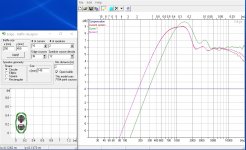
I will look into Basta. I'm also thinking about trying a prototype out too, as it makes a lot of sense to me.
Thinking about the info gathered these last days I'm thinking the 18" needs to be raised from the floor probably about 12" (bottom edge to floor) and probably needs a baffle similar to your design. That would put the top edge of the 18" at 30" from the floor, plus 2 or 3" edge it would be 33". I'm thinking I would need to place the tweeter above the 18", and the 1.5 midrange above the tweeter.
What's your take on drivers such my midbasses held on swings, from the magnet? I can feel no vibration transmitted to the frame holding the swing (the back-to-front vibrations from the cone work in Newton's action/reaction fashion and no vertical vibrations move up the swing, I think).
I simulated on Edge:
- 1 naked 8PE21 (shown in green, Curve 1)
- 1 8PE21 on an oval baffle 250 x 450mm, where the woofer is placed at the top (shown purple, Curve 2)
- 2 8PE21 on same baffle as above. Top woofer placed on same spot, and second woofer below.
It looks like you are only simulating the "on axis" response. Since you can check the responses on other axes in the Edge very easily, it is a mistake not to. The response off axis is quite important. Just designing for on axis response is a novice mistake IMHO, for any DIY speaker builder and for any type of speaker, not just OB/dipole.
In the edge, what I do is that I start with the mic on axis at some reference position. I usually choose where the tweeter will be located for the system, not in the middle of the woofer(s). The Edge has an icon in the bar at the top that looks like a blue sheet over a round ball or something.It's just to the right of the icon that looks like a pencil. This is the "freeze curve" action. If you click that, the program creates a fixed trace in the plot that is identical to the currently simulated response. Now move the "mic" off to one side horizontally. You will see the "frozen" curve and the one at the new position. Move the mic over until you get a few dB difference in the curves, freeze the new curve, and repeat. I try to get four or five curves on the plot.
Once you have your family of curves you can look for problems. These will include frequencies where the curves will pinch together, or cross, or other undesirable things.
Usually if you increase the baffle size somewhat these will always develop. At the same time the dipole peak will broaden as you described. As the designer you will need to decide which of these features is desirable/undesirable and trade off baffle size with them.
Sorry if you already knew about this kind of thing, but I got the idea you were only looking at the on axis response and might be missing out on some important information that is good to consider as well.
Also, the Edge does not know anything about how the drivers are wired and I think it normalizes responses by the total output, so adding more drivers does not change the magnitude per se. You can think of it as providing only the effect of the baffle given a fixed amount of acoustic energy being radiated. Or something along those lines.
Last edited:
It looks like you are only simulating the "on axis" response. Since you can check the responses on other axes in the Edge very easily, it is a mistake not to. The response off axis is quite important. Just designing for on axis response is a novice mistake IMHO, for any DIY speaker builder and for any type of speaker, not just OB/dipole.
In the edge, what I do is that I start with the mic on axis at some reference position. I usually choose where the tweeter will be located for the system, not in the middle of the woofer(s). The Edge has an icon in the bar at the top that looks like a blue sheet over a round ball or something.It's just to the right of the icon that looks like a pencil. This is the "freeze curve" action. If you click that, the program creates a fixed trace in the plot that is identical to the currently simulated response. Now move the "mic" off to one side horizontally. You will see the "frozen" curve and the one at the new position. Move the mic over until you get a few dB difference in the curves, freeze the new curve, and repeat. I try to get four or five curves on the plot.
Once you have your family of curves you can look for problems. These will include frequencies where the curves will pinch together, or cross, or other undesirable things.
Usually if you increase the baffle size somewhat these will always develop. At the same time the dipole peak will broaden as you described. As the designer you will need to decide which of these features is desirable/undesirable and trade off baffle size with them.
Sorry if you already knew about this kind of thing, but I got the idea you were only looking at the on axis response and might be missing out on some important information that is good to consider as well.
Also, the Edge does not know anything about how the drivers are wired and I think it normalizes responses by the total output, so adding more drivers does not change the magnitude per se. You can think of it as providing only the effect of the baffle given a fixed amount of acoustic energy being radiated. Or something along those lines.
Thank you Charlie.
Indeed, I was mixing two different things in what I showed. I started looking at naked 8" vs narrow oval baffle for it, and then diypole proposed the 0.5 second 8" to complement the lower end of the midrange to get to 250Hz, and I tried simulating in Edge. Then I noticed one or two drivers were showed with same SPL, which didn't make sense to me, which triggered my post. I just focused on the on-axis response to simplify the example of 1 vs 2 drivers providing the same SPL. I can see how it was confusing though.
I will do as you say for different baffle shapes. But it seems a good starting point to go oval and narrow around the midranges.
I also need to experiment with baffles (narrower, not), and naked with the 18" midbass raised from the floor. I hope to get to 50Hz with the 18" so to hand over to the 12" sealed subs there, also per your posts and diypole. Maybe I can get there with a minimum baffle.
This weekend, reading your posts I learnt why the 18" midbass should not be close to the floor as I have it now. This, plus a double 8" midrange section will make the speaker tall. Might need to send the midranges above the tweeter.
I've always used Soundeasy, but after fooling around with basta and edge a bit this past week, I like how quick and easy they are to use.
Also nice that the loudspeaker database site has basta files for many drivers. Just click and boom, they're in there. I found every driver I currently have on that site.
Edge is useful for looking at the driver diameter and shape in relation to the baffle size and shape, but not taking into account volume displacement and electro mechanical parameters.
It does tell you a lot about directivity and considering off axis response measurements when choosing your crossover point.
When Linkwitz came out with the pluto, I did a study of drivers mounted in the end of pipes, in sizes up to 8". Between that and working on dipoles I learned a tremendous amount about directivity, and used 90 degree off axis measurements as the main consideration in my crossover point and slope from then on, whether sealed or open baffle.
Bear in mind that the off axis response when you go north or south off the end of the baffle is not going to be accurate in edge without the inductor between them. Comparing vertical off axis to horizontal off axis shows that edge is taking driver interactions into account, and vertical directivity will not be affected the same way when one driver is coming in at a lower frequency.
Also nice that the loudspeaker database site has basta files for many drivers. Just click and boom, they're in there. I found every driver I currently have on that site.
Edge is useful for looking at the driver diameter and shape in relation to the baffle size and shape, but not taking into account volume displacement and electro mechanical parameters.
It does tell you a lot about directivity and considering off axis response measurements when choosing your crossover point.
When Linkwitz came out with the pluto, I did a study of drivers mounted in the end of pipes, in sizes up to 8". Between that and working on dipoles I learned a tremendous amount about directivity, and used 90 degree off axis measurements as the main consideration in my crossover point and slope from then on, whether sealed or open baffle.
Bear in mind that the off axis response when you go north or south off the end of the baffle is not going to be accurate in edge without the inductor between them. Comparing vertical off axis to horizontal off axis shows that edge is taking driver interactions into account, and vertical directivity will not be affected the same way when one driver is coming in at a lower frequency.
I've been playing around with Basta.
I couldn't get into the driver database: on Basta>Help>Basta driver database sends me to a website (Basta driver database) and clicking on the "driver database" link I get a 404 error message. I'm doing this on Chrome. Are accessing the database differently?
Anyway, I entered the 8PE21 parameters, selected "baffle" in the "box" tab, went into baffle designer and threw in an oval baffle approx the same as what I was using on Edge. Using 1 vs 2 drivers shows the 6dB SPL difference I was expecting. This is good!
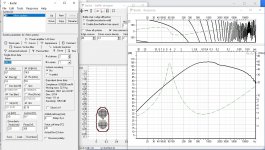
I'm keeping the mic on axis vertically and horizontally for simplicity, for now.
Now onto the inductor between the 8PE21, where I'm not sure I'm interpreting correctly. My understanding is I want both both 8PE21 connected in parallel to the amp, with an inductor in series between the amp and one of the woofers so it will only reproduce the bottom end of the range received by the amp. From looking at the above graph I'm using 400Hz as starting point for this passive 1st order xo. O Basta, I select the passive filter tab, low pass filter first order, 400Hz:
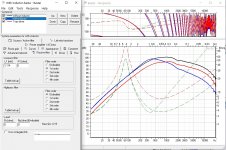
Blue line is 2 drivers with the inductor, black is two drivers without inductor, red line is only the top driver. I think the blue line is looking like I wanted, right?
I couldn't get into the driver database: on Basta>Help>Basta driver database sends me to a website (Basta driver database) and clicking on the "driver database" link I get a 404 error message. I'm doing this on Chrome. Are accessing the database differently?
Anyway, I entered the 8PE21 parameters, selected "baffle" in the "box" tab, went into baffle designer and threw in an oval baffle approx the same as what I was using on Edge. Using 1 vs 2 drivers shows the 6dB SPL difference I was expecting. This is good!

I'm keeping the mic on axis vertically and horizontally for simplicity, for now.
Now onto the inductor between the 8PE21, where I'm not sure I'm interpreting correctly. My understanding is I want both both 8PE21 connected in parallel to the amp, with an inductor in series between the amp and one of the woofers so it will only reproduce the bottom end of the range received by the amp. From looking at the above graph I'm using 400Hz as starting point for this passive 1st order xo. O Basta, I select the passive filter tab, low pass filter first order, 400Hz:

Blue line is 2 drivers with the inductor, black is two drivers without inductor, red line is only the top driver. I think the blue line is looking like I wanted, right?
Sorry, I was referring to this loudspeaker database
Loudspeaker Database
To be clear, the amp outputs should go first to the upper midrange, and then on to the lower midrange, but with the inductor in between them on the positive side. The upper midrange gets the full signal, and then the lower mid is rolled in at a lower frequency.
Not that familiar with Basta, and whether or not you can apply the inductor in between the drivers so it just affects the second, lower midrange.
Loudspeaker Database
To be clear, the amp outputs should go first to the upper midrange, and then on to the lower midrange, but with the inductor in between them on the positive side. The upper midrange gets the full signal, and then the lower mid is rolled in at a lower frequency.
Not that familiar with Basta, and whether or not you can apply the inductor in between the drivers so it just affects the second, lower midrange.
Project has been slow, but made some progress. Learnt how to build inductors, design, sourced the copper wire and epoxy. The double 8" still in the making. But my current iteration can't accommodate a second 8":
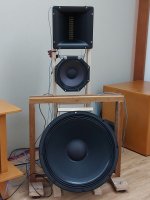
So built a quick and dirty second iteration for the 18", that lifts the lower 18" edge 10" from the floor, will allow me to test a panel on them, and to fix a new stand for the double 8"s atop:
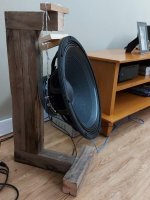
Having fun with these. Playing bass rich albums with recorded with high dynamic range is amazing. Patricia Barber Cafe Blue now. Fun!

So built a quick and dirty second iteration for the 18", that lifts the lower 18" edge 10" from the floor, will allow me to test a panel on them, and to fix a new stand for the double 8"s atop:

Having fun with these. Playing bass rich albums with recorded with high dynamic range is amazing. Patricia Barber Cafe Blue now. Fun!
Last edited:
I experimented with baffles to get the 18" maybe to 50Hz and the 8" to 200-250Hz, but hit a roadblock: WAF! She prefers the look of baffleless.
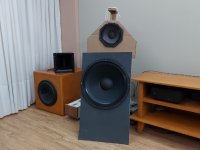
Building on diypole's suggestion to use twin 8" and an inductor in between to let them reach lower. I'm thinking the 8PE21 isn't well suited to go low baffleless. Maybe a better approach would be to add a 12" in parallel to the 18" and have an inductor in between so the 12" plays all the way to 400Hz and the 18" plays up to 200Hz. Would get these benefits:
1) higher sensitivity from hi pass of midbass to 200Hz
2) 4 ohm load seen by midbass class-D amp
3) avoid directivity issues above 200Hz from thec18"
4) let the 8" midrange work where it's best at.
What are downsides I'm probably missing?

Building on diypole's suggestion to use twin 8" and an inductor in between to let them reach lower. I'm thinking the 8PE21 isn't well suited to go low baffleless. Maybe a better approach would be to add a 12" in parallel to the 18" and have an inductor in between so the 12" plays all the way to 400Hz and the 18" plays up to 200Hz. Would get these benefits:
1) higher sensitivity from hi pass of midbass to 200Hz
2) 4 ohm load seen by midbass class-D amp
3) avoid directivity issues above 200Hz from thec18"
4) let the 8" midrange work where it's best at.
What are downsides I'm probably missing?
Hi,
The downside is that you´ll have 2 different drivers working in the same frequency region. I can´t imagine that this will not have disadvantages, but to be honest, I never tried...
An alternative approach would be to use 2 identical 12" or 15" drivers, 2 in lower bass, 1 in upper bass and lower mids.
All the best
Mattes
The downside is that you´ll have 2 different drivers working in the same frequency region. I can´t imagine that this will not have disadvantages, but to be honest, I never tried...
An alternative approach would be to use 2 identical 12" or 15" drivers, 2 in lower bass, 1 in upper bass and lower mids.
All the best
Mattes
Thank you Mattes! Indeed, a rather evident and significant downside that I had neglected.
Thinking two 12" would indeed allow to play with higher xo than 18", but would have 12% less surface than the 18"...makes me shy away from that path. They would present a 4 ohm load to the amp, so this aspect is attractive.
Twin 15" would allow a higher xo, maybe 300Hz (I noticed Vitalica built his with twin 15" and 250Hz xo, guided by Acoustic Elegance advise) so better than the 18" but probably not low enough for the 8PE21. They would have about 35% more surface than a single 18" and that would be nice. Would end up with a tall speaker like Vitalica, and might get the WAF looks again. 😱
So seems like what diypole suggested is the safest approach for now: use two 8" and let both play the lower end of that range and only one playing top of that range. I can test this without buying more drivers too.
Next question guess is should I do MTM, TMM? MTM has the advantage of keeping the tweeter at ear height, but might cause lobbing although at those frequencies might not be significant.
I modeled MTM on Edge. Just the twin 8", but allowing for the space in between for the tweeter. I guess the lower 8" would play the whole 250 to 1500Hz while the top would play only 250 to 700Hz or so.
Modelled: naked 8" (curve 1), MTM on a 300x650mm baffle (curve 2), MTM on a 250x650mm baffle (curve 3), MM side by side on a 460x250mm baffle.
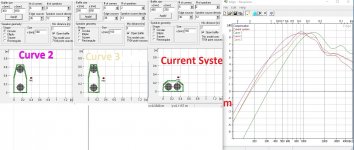
The two drivers are modelled as playing the whole range, but I think the takeaway is two drivers and a baffle will provide 4 to 5dB extra at 250Hz, and the narrower baffle is likely to reach higher in a cleaner way. In fact, maybe I should let the top 8" play 250 to 1500Hz since it will have the narrowest baffle around it.
The MM side by side it's interesting. In fact, according to Edge it would match the highest sensitivity at 250Hz while also reaching higher. Would you expect this to mimic reality? Would two sources playing the midrange create a diffuse soundstage? Likely to hit WAF issues, but let's start with sound aspects.
Thoughts?
Thinking two 12" would indeed allow to play with higher xo than 18", but would have 12% less surface than the 18"...makes me shy away from that path. They would present a 4 ohm load to the amp, so this aspect is attractive.
Twin 15" would allow a higher xo, maybe 300Hz (I noticed Vitalica built his with twin 15" and 250Hz xo, guided by Acoustic Elegance advise) so better than the 18" but probably not low enough for the 8PE21. They would have about 35% more surface than a single 18" and that would be nice. Would end up with a tall speaker like Vitalica, and might get the WAF looks again. 😱
So seems like what diypole suggested is the safest approach for now: use two 8" and let both play the lower end of that range and only one playing top of that range. I can test this without buying more drivers too.
Next question guess is should I do MTM, TMM? MTM has the advantage of keeping the tweeter at ear height, but might cause lobbing although at those frequencies might not be significant.
I modeled MTM on Edge. Just the twin 8", but allowing for the space in between for the tweeter. I guess the lower 8" would play the whole 250 to 1500Hz while the top would play only 250 to 700Hz or so.
Modelled: naked 8" (curve 1), MTM on a 300x650mm baffle (curve 2), MTM on a 250x650mm baffle (curve 3), MM side by side on a 460x250mm baffle.

The two drivers are modelled as playing the whole range, but I think the takeaway is two drivers and a baffle will provide 4 to 5dB extra at 250Hz, and the narrower baffle is likely to reach higher in a cleaner way. In fact, maybe I should let the top 8" play 250 to 1500Hz since it will have the narrowest baffle around it.
The MM side by side it's interesting. In fact, according to Edge it would match the highest sensitivity at 250Hz while also reaching higher. Would you expect this to mimic reality? Would two sources playing the midrange create a diffuse soundstage? Likely to hit WAF issues, but let's start with sound aspects.
Thoughts?
Hola Senor,
The thing I don´t fully understand is what issues you have with your 18"? My feeling is that a good 18" should have no problems whatsoever at 300Hz and even a little bit higher. Theoretically you´re running into beaming area, but in practice that´s no hard border, and practical disadvantages should be very small. Over here, I´m still happy with my 18" in OB, passive filtered at around 300Hz, no problems at all, but of course ymmv.
If you go the double 8" MTM route, you may try the other way round as well: the lower 8" from 250-700, the upper one from 250-1500. That´s just a feeling of mine though...
But then I think that 18" from 50Hz to 300Hz, 8" from 300Hz to 1500Hz and AMT above should be possible with either small amounts of EQ or small minimum baffles (just a little bit bigger than the drivers, edges well rounded, real wood for WAF...).
All the best
Mattes
The thing I don´t fully understand is what issues you have with your 18"? My feeling is that a good 18" should have no problems whatsoever at 300Hz and even a little bit higher. Theoretically you´re running into beaming area, but in practice that´s no hard border, and practical disadvantages should be very small. Over here, I´m still happy with my 18" in OB, passive filtered at around 300Hz, no problems at all, but of course ymmv.
If you go the double 8" MTM route, you may try the other way round as well: the lower 8" from 250-700, the upper one from 250-1500. That´s just a feeling of mine though...
But then I think that 18" from 50Hz to 300Hz, 8" from 300Hz to 1500Hz and AMT above should be possible with either small amounts of EQ or small minimum baffles (just a little bit bigger than the drivers, edges well rounded, real wood for WAF...).
All the best
Mattes
Hola Senor,
The thing I don´t fully understand is what issues you have with your 18"? My feeling is that a good 18" should have no problems whatsoever at 300Hz and even a little bit higher. Theoretically you´re running into beaming area, but in practice that´s no hard border, and practical disadvantages should be very small. Over here, I´m still happy with my 18" in OB, passive filtered at around 300Hz, no problems at all, but of course ymmv.
If you go the double 8" MTM route, you may try the other way round as well: the lower 8" from 250-700, the upper one from 250-1500. That´s just a feeling of mine though...
But then I think that 18" from 50Hz to 300Hz, 8" from 300Hz to 1500Hz and AMT above should be possible with either small amounts of EQ or small minimum baffles (just a little bit bigger than the drivers, edges well rounded, real wood for WAF...).
All the best
Mattes
Hey Mattes!
Thanks for the questions to help me think! I'm looking into two "issues" around the 18":
1) Can I get below 70Hz to cross to subs as I have them today? This is the purpose of the baffle.
2) I understand the ideal xo would be 200Hz for an 18" because of beaming. I have them at 400Hz today because my 8" in particular aren't very good getting closer to ideal if running baffleless.
So my most significant issue is the low end of the midrange, which is why I was testing a baffle for mids and why Diypole suggested the second 8" with an inductor.
I assembled a test open baffle MTM today. I lowered the 18" to the tweeter stays at ear level and naturally shortened the baffle. The tweeter is the same OB with waveguides from before, and both 8" are running the whole 400 to 1500Hz for now. I need to measure these, decide where to cross the 2nd 8" and wind the inductor. For the time being I dropped the swinging midranges, but will revisit down the road. I'm thinking the top 8" will be the one going up to 1500Hz which would allow for the baffle around it to be narrower (like 2cm around it). FWIW, so far I haven't noticed lobbing.
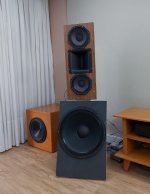
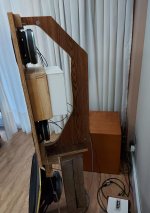
It's 140cm tall and the lower edge of the 18" is 18cm from the floor.
Your suggestion about 250-700Hz for 8" #1 and 250-1500Hz for 8" #2 is what Diypole suggested too. Seems a good idea, and I'm after testing it.
Great to know you cross the 18" at 300Hz and have no beaming issues. The twin 8" should get to 300Hz easily with a narrow baffle.
Can't wait to go measure.
Hola Senor,
Good luck! But I must say that doesn´t look too bad... could imagine that if the baffles were trapezoidal, matching width at the gap, from nice wood WAF may be acceptable again...
All the best
Mattes
Good luck! But I must say that doesn´t look too bad... could imagine that if the baffles were trapezoidal, matching width at the gap, from nice wood WAF may be acceptable again...
All the best
Mattes
- Home
- Loudspeakers
- Multi-Way
- 3-way open baffle plus subs